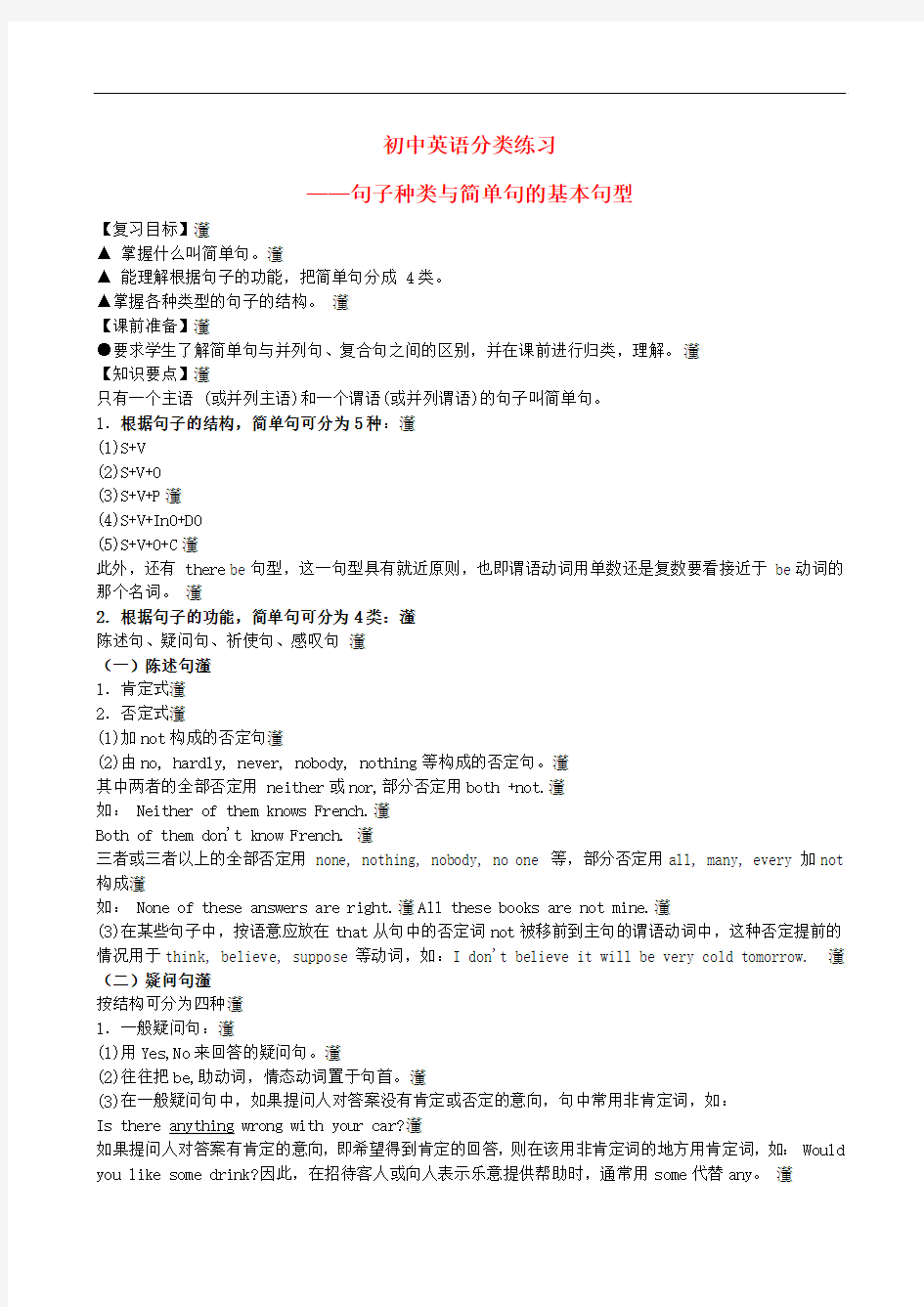句子种类与简单句的基本句型用法详解 史上最小白的讲解与练习


初中英语分类练习
——句子种类与简单句的基本句型
【复习目标】
▲ 掌握什么叫简单句。
▲ 能理解根据句子的功能,把简单句分成 4类。
▲掌握各种类型的句子的结构。
【课前准备】
●要求学生了解简单句与并列句、复合句之间的区别,并在课前进行归类,理解。
【知识要点】
只有一个主语 (或并列主语)和一个谓语(或并列谓语)的句子叫简单句。
1.根据句子的结构,简单句可分为5种:
(1)S+V
(2)S+V+O
(3)S+V+P
(4)S+V+InO+DO
(5)S+V+O+C
此外,还有 there be句型,这一句型具有就近原则,也即谓语动词用单数还是复数要看接近于be动词的那个名词。
2.根据句子的功能,简单句可分为4类:
陈述句、疑问句、祈使句、感叹句
(一)陈述句
1.肯定式
2.否定式
(1)加not构成的否定句
(2)由no, hardly, never, nobody, nothing等构成的否定句。
其中两者的全部否定用 neither或nor,部分否定用both +not.
如: Neither of them knows French.
Both of them don't know French.
三者或三者以上的全部否定用 none, nothing, nobody, no one等,部分否定用all, many, every加not 构成
如: None of these answers are right. All these books are not mine.
(3)在某些句子中,按语意应放在that从句中的否定词not被移前到主句的谓语动词中,这种否定提前的情况用于think, believe, suppose等动词,如:I don't believe it will be very cold tomorrow. (二)疑问句
按结构可分为四种
1.一般疑问句:
(1)用Yes,No来回答的疑问句。
(2)往往把be,助动词,情态动词置于句首。
(3)在一般疑问句中,如果提问人对答案没有肯定或否定的意向,句中常用非肯定词,如:
Is there anything wrong with your car?
如果提问人对答案有肯定的意向,即希望得到肯定的回答,则在该用非肯定词的地方用肯定词,如: Would you like some drink?因此,在招待客人或向人表示乐意提供帮助时,通常用some代替any。
2.特殊疑问句:
用疑问代词或疑问副词提问的句子,不用Yes,No回答。
(1)疑问词作句子的宾语、状语、表语或修饰这三种成份时,用疑问词+一般疑问句,
如: When will you go?
(2)疑问词作主语或主语的定语时,与陈述句的顺序相同,
如:
Whose father works in Shanghai?
Who is on duty today?
3.反意疑问句
(1)构成:陈述句+ 简略问句
肯定否定
否定肯定
简略问句的主语与陈述句保持一致,只能用人称代词 (there除外),简略问句的谓语动词也与陈述句保持一致,如果是否定,一定要用简写。如:
Jim isn't a student, is he?/There are some books in it, aren't there?
(2)陈述部分I'm...结构,疑问部分一般用aren't I,如:
I'm late, aren't I?
(3)陈述句中有little, few, no, never, nothing, nobody, hardly等词表示否定时,简略问句用肯定。
(4)陈述句中有指物的不定代词nothing, something, anything时,简短问句中用代词it,陈述句中有指人的不定代词everyone, no one, someone, everybody, nobody, anybody时,简短问句中用代词he或they,如:Everyone is here, aren't they/isn't he?
(5)陈述句的主语是指示代词this, that等时,疑问部分的主语在形式上与前者不同,但在逻辑上却与前者一致,如:This is very important, isn't it?
(6)陈述部分如果是“I (don't) think (believe, suppose...)+宾语从句”时,疑问部分中的动词和主语应与宾语从句中的主语和动词保持一致,如:I don't believe she knows it, does she?
(7)含有情态动词must的句子表示猜测时,疑问部分与must后面部分一致,不能用mustn't,如:You must be tired, aren't you?当must表示“有必要”时,疑问部分用needn't,如:You must go home right now, needn't you?当mustn't表示禁止时,疑问部分一般用must,如:
You mustn't walk on grass, must you?
(8)祈使句的反意疑问句
肯定祈使句 +will you/won't you?
否定祈使句 +will you?
Let's...+shall we?(包括对方)
Let us...+will you?(不包括对方)
(9)感叹句的反意疑问句一律用否定式,并用be的一般现在时,如:
What a lovely girl, isn't she?
(10)前面否定后面肯定的反意疑问句在回答时,需根据其实际情况,实际情况是肯定的,则用Yes+肯定结构,实际情况是否定的,则用No+否定结构,如:
— You can't speak English, can you?
— Yes, I can(不,我会的)
(11)关于“'d”和“'s”
注意比较:
He'd like a cup of tea, wouldn't he?/You'd better go now, hadn't you?
He's never late for school, is he?/He's never been there, has he?
4.选择疑问句:选择疑问句是用or连接询问的两部分,以供选择,答案必须是完整的句子或其省略形式,不能用Yes或No回答,如:Are you Jim or Tom?I'm Tom.
(三)祈使句
用以表示命令、请求或建议,主语通常省略。
肯定式谓语用动词原形,否定式用“ Don't (Never)+动词原形”,Stand up, please./Don't be afraid.
(四)感叹句
用以表示快乐、痛苦等强烈感情的句子称为感叹句。
感叹句有用 how或what开头的两种形式。
1.How开头的感叹句
(1) How+形容词(副词)+主语+谓语。如:
How beautiful the flower is!
(2) How修饰动词,句型是“How+主+谓”,如:
How I wish I could hear Beethoven himself play it!
(3) How+形容词(副词),省略主语和谓语,如:
How interesting(it is)!
2.what开头的感叹句:
(1)What+(a)+形容词+名词+主语+谓语,如:
What a nice horse it is! What fine weather! What good news!
(2)What(a)+名词!
What a pity!
二、句子的成分
组成句子的各个部分叫句子成分。句子的各种成分包括主语、谓语、表语、宾语、定语、状语等。
主语句子的主体,发出动作的人或物,表示所说的是谁或是什么。主语一般放在句首,特殊句型中,在句末,由名词、代词或相当于名词的词或短语充当。如:
He was born in a small village.他出生在一个小村庄。
谓语说明主语的动作特征状态等,由动词或动词短语构成。如:
She told me about that story.
主谓一致:主语和谓语必须在人称、数两方面保持一致。主谓一致的关键是判断主语是单数还是复数。1. 一般情况主语的数比较明确如:
His mother works in a office.她妈妈在办公室工作。
2. and 连接的两个或两个以上名词或代词做主语时,谓语动词用复数形式。如:
Linda and Susan are from America.琳达和苏珊来自美国。
3. each, either, neither, another做主语时,谓语动词用单数。如:
Neither of us has been to France.我们两个都没去过法国。
4. 由some, any, no, every构成的合成代词作主语时,谓语用单数。如:
No one knows his phone number.没有人知道他的电话号码。
5. 由either…or…;neither…nor…;not only…but also…构成的合成代词作主语时,谓
语与距离最近的主语保持一致。如:
Not only my friends but also my sister agrees with me.我的朋友和我的妹妹都赞同我。
6. 集合名词people, police等作主语时,位于用复数。如:
The people were surprised to see him dancing in the street.人们很惊讶的看他在街上跳舞。
7. 集合名词family, class等作主语时,如看作整体,谓语用单数。如强调个体,则谓语
用复数。如:
My family has lived here for twenty years. 我们家在这里住了20年了。
His family were watching TV while the phone rang.电话响起时,他们全家在看电视。
8. some, any, none, half 作主语时,谓语动词的单、复数形式视情况而定。如:
Half of the students are boys. 一半学生是男生。
Half is enough.一半就够了。
9. 时间、距离、重量、数量、价值等名词附属作主语时,谓语动词常用单数。如:
Ten years is not a long time.十年不算太久。
表语用来说明主语的身份、特征、状态等,位于连系动词后。可作表语的有名词、代词、形容词、数词、副词、动词不定式、介词短语、分词短语及从句等。如:
Is this pen yours? 这笔是你的吗?
宾语是动作的承受者。及物动词及相当于及物动词的短语后都必须带宾语。名词、代词、动名词、不定式和从句均可作宾语。如:
The little boy waited his mother to buy him hamburgers.这个小男孩想让他妈妈给他买汉堡。
有些动词需要两个同等的宾语,即直接宾语和间接宾语。直接宾语一般指动作的承受者,间接宾语指动作所向的或所为的人或物(多指人)。后接双宾语的动词有:answer, bring, buy, deny, do, fetch, find, get, give, hand, keep, leave, lend, make, offer, owe, pass, pay, play, promise, read, refuse, save, sell, send, show, sing, take, teach, tell, throw, wish, write等。间接宾语一般于直接宾语连用,通常放在直接宾语之前。如:
She made her son a birthday cake.她给她儿子做了一个生日蛋糕。
They sent me a letter.他们给我寄了一封信。
定语修饰名词或代词的句子成分。可以做定语的有名词、代词、数词、形容词、副词、动词不定式、介词短语、动名词、分词短语及从句等。形容词作定语放在名词之前,副词或副词短语时常放在名词后。如:
What a lovely day! 多好的日子啊!
I have a lot of work to do. 我有许多工作要做。
状语用来修饰动词、形容词、副词的句子成分称为状语。状语用来说明时间、地点、条件、原因、方式、程度、目的、结果等。可用作状语的有副词、不定式短语、分词短语、介词短语及从句等。如:He’s waiting for me in front of the library.他在图书馆前面等我。
They came to see me yesterday.他们昨天来看我了。
初中英语分类练习
——非谓语动词
Ⅰ. 填空
(A) 用括号中的动词适当形式填空
1.We are so glad ________ (hear) the news.
2.I saw him ________ (cross) the road safely and ________ (run) away.
3.You can’t make him ________ (do) what you want.
4.I don’t know where ________ (meet) him.
5.What makes you ________ (think) I’m a farmer?
6.Did you see him ________ (go) upstairs?
7.It is better ________ (put) your money in a bank.
8.It is difficult for the boy ________ (swim) across the river.
9.I let him ________ (go) early as he wanted ________ (meet) his uncle at the station.
10.Will you help me ________ (move) the bed?
11.If he doesn’t know, how ________ (use) the recorder, you’d better ________ (show) him.
12.He is the last one ________ (leave) the office every day.
13.It’s bad manners ________ (shout) in public.
14.The boy is old enough ________ (dress) himself.
15.She is too ill ________ (go) to school.
(B) 填入动名词的适当形式.
1.Can you imagine yourself ______ in a lonely island? (stay)
2.I can't understand your ______ at that poor child.(laugh)
3.She didn't mind _______ overtime.(work)
4.To make a living, he tried _______, ________,and various other things,
but he had failed in all .(write; paint)
5.We are looking forward to Mary's________ . (come) .
6.She was praised for _______ the life of the child.(save)
7.She ought to be praised instead of ______ (criticize).
8.Is there any possibility of our ______ the championship?(win)
9.He came to the party without _______(invite)
10. Don’t keep me __________(wait) for a long time.
11. Knives are used for ______________(cut) things.
12. Can you finish ___________(read) the book in three days?
13. The doctor was busy ____________(operate) on the boy at that time.
14. Stop ___________(talk) and listen to me carefully.
15. Thank you very much for ____________(help) us.
16. Granny is very ill and she doesn’t feel like ___________(eat) anything.
17. The girl enjoys ___________(listen) to light music.
18. Do you remember ___________(buy) me a beautiful skirt on my 13th birthday?
19. We couldn’t help _________(laugh) after we heard the funny story.
20. What about ___________(go) out for a walk?
Ⅱ. 用不定式完成下列句子
1.Have you decided ________(怎样度假).
2.It is dangerous ________(玩火).
3.She was the first woman ________(环球飞行的).
4.The boy was made ________(重复他自己的故事).
5. The old lady looked at the children ________(穿过马路).
6.It took me much time ________(算出这些难题)yesterday.
7.The boss made the workers ________(一天工作十小时).
8.I don’t know ________(在会上说什么).
9.Can you tell me ________(在哪里能买到这本书)?
10.________(在何时何地召开这会议)hasn’t been decided yet.
Ⅲ.根据句意改写句子
